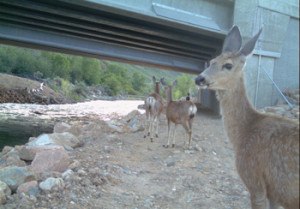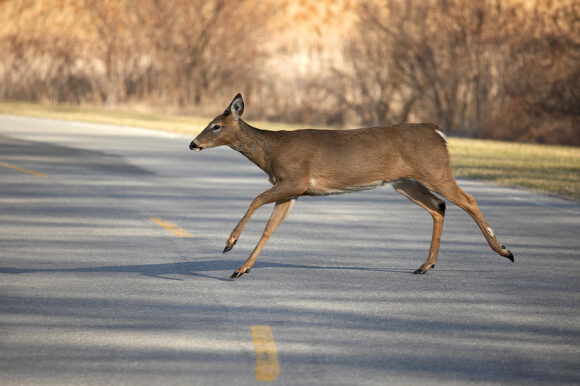You’ve seen them – the yellow signs along the state’s rural roadways that warn of a deer crossing ahead.

Trouble is, researchers say, we mostly ignore such warnings.
It presents a quandary for highway safety officials in Nebraska seeking to head off collisions between critters and cars in Nebraska.
“There’s a lot of research that says we use too many signs. It’s something we all need to be aware of,” said Kyle Schneweis, director of the Nebraska Department of Transportation.
Now is the peak season for driving into a deer. About 20 percent of the about 2,200 collisions a year between vehicles and deer happen during November. October is the second-highest month for deer strikes, according to state highway safety figures.
Deer are not only in the midst of mating season but are being pushed out of tranquil fields by harvesting machines and hunters.
“You’ve got them moving everywhere,” said Fred Zwonechek, the state’s highway safety director.
In Nebraska and Iowa, your chances of hitting a deer are pretty good. The odds in the Cornhusker State were put at 1 in 149, according to recent projections by State Farm Insurance, while the odds in Iowa were about twice that – 1 in 73. The Hawkeye State ranked fifth-highest in the country, behind leading road-kill states like West Virginia, Montana and Pennsylvania. Nebraska ranked 26th.
If there’s any good news, it’s that Nebraska’s deer population hasn’t yet rebounded totally from a disease outbreak in 2011-12. That’s reflected in the deer harvest numbers, which used to number more than 3,000 a year before plunging in 2012.
In Minnesota, another leading deer collision state, state roads workers are no longer replacing deer crossing signs because of their lack of effectiveness. In one county, Carver County just west of the Twin Cities, workers are removing the warning signs because they think it gives people a false impression about where deer are likely to cross.
“In Minnesota, anywhere you’re traveling, including in the metropolitan Minneapolis-St. Paul area, you have to be alert for deer,” said Peter Buchen, assistant traffic engineer for the Minnesota Department of Transportation.
Schneweis said Nebraska roads workers aren’t going to that extreme but have become more careful about where deer crossing signs are placed.
The signs, which cost about $250 each to produce and erect, are placed only in places where there have been three deer-vehicle crashes per year for five years in a one-mile stretch of highway. At a smaller, specific site, like near a bridge, the standard is five crashes per year, the Omaha World-Herald reported.
“We look at the data,” Schneweis said. “If there’s not a prevalence of deer crashes, we don’t put them up.
“If you spread out warning signs too much, you stop paying attention to them.”
Roads officials in Douglas and Sarpy Counties also said they use some discretion about where to post deer crossing signs, but don’t have specific criteria.
Tom McDonald, construction and maintenance manager for the Douglas County Highway Department, said the placement of such signs is guided by requests from the public and where deer have been seen crossing regularly.
“They’re a warning sign,” McDonald said. “If people pay attention, who knows?”
Installation of such signs is an “engineering judgment call” because there is a lack of solid guidance, according to Pat Dowse, chief deputy Sarpy County highway engineer.
Of course, deer don’t always cross where the signs are placed.
Researchers have concluded that, in particular, signs that warn of infrequent dangers, such as deer, icy roads or playing children, are often ignored by motorists. The Federal Highway Administration reported to Congress in 2008 that a study conducted in 15 Kansas counties showed no relationship between the installation of static deer warning signs and crash rates.
So what are we and highway safety folks to do to prevent accidents with animals? They cause an estimated $1 billion in property damage a year nationally and led to 181 fatalities in 2016.
Dozens of strategies have been tried, with mixed to little impact – from mounting high-frequency “deer whistles” on cars to scare off deer to spreading deer “repellent” along highways to keep them away. Years ago, Nebraska roads officials installed red “flashers” along a highway that deflected light from headlights into adjacent woodlands to ward off the deer, with little impact.
Schneweis said that self-driving cars may in the future provide a warning via radar systems that detect approaching wildlife.
But for now, the most effective deterrent is tall, deer-proof fencing, like that installed along Interstate 80 from Mahoney State Park northward across the Platte River into Sarpy County. But that kind of fencing is expensive, about $300,000 per mile, and requires frequent maintenance.
Roadside systems that detect approaching deer and activate a flashing warning on a sign fall into the same, expensive category and sometimes flash false warnings.
Some states have built wildlife “overpasses” or underpasses to safely funnel wildlife, like endangered Florida panthers and Canadian moose and bear, over or under busy freeways. Nebraska has at least one wildlife underpass, for threatened Blanding’s turtles, on a remote highway in the Sand Hills. And some Interstate bridges near the deer fencing in Sarpy County were modified to allow deer to pass beneath I-80.
Overall, officials said that motorists just need to be alert, particularly in low-lying wooded areas where deer are more frequent, and be ready to slow down if deer are visible near the road. At night, use your brights. And always anticipate that if you see one set of eyes, another deer is nearby.
“You’ve just got to be prepared to look for them,” Zwonechek said.
Was this article valuable?
Here are more articles you may enjoy.


 California Governor Seeks $200M to Replace EV Tax Credits Cut by Trump
California Governor Seeks $200M to Replace EV Tax Credits Cut by Trump  Musk’s X Probed by UK Over Grok’s Thousands of Sexualized Images
Musk’s X Probed by UK Over Grok’s Thousands of Sexualized Images  First Brands Judge Approves Examiner to Probe Fraud Allegations
First Brands Judge Approves Examiner to Probe Fraud Allegations  Palantir Poaching Suit Called ‘Scare’ Tactic by Ex-Employees
Palantir Poaching Suit Called ‘Scare’ Tactic by Ex-Employees 